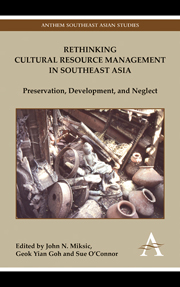Chapter 10 - Innovation versus Preservation: Heritage Management and Burmese Traditional Performing Arts
from Myanmar
Published online by Cambridge University Press: 05 May 2012
Summary
Introduction
Bagan was the capital of a vast kingdom between the eleventh and thirteenth centuries. Today it is a dusty conglomeration of hundreds of brick temples among which wander a few tourists, horse cart drivers and local farmers who have been forced by the government to move to the fringes of the site, 5km away, in the towns of New Bagan and Nyaung-U. The darkness of the nights is partially relieved by scattered temple lamps sponsored by Buddhist devotees.
For a few nights a year, powerful rhythmic beats of the Burmese saing waing (drum circle orchestra) draw crowds from a temporary marketplace in the forecourt of the Alopyi temple. Tourists are rarely present at these performances. The drums pound out pulsating traditional music for a few hours before the zat pwe begins. Osnes and Gill (2001, 376) described zat pwe as a mixture of classical Thai and Burmese dance and Western ballet. Less than a decade later, another observer defined it differently: an all-night Burmese variety show or vaudeville performance consisting of a potpourri of traditional songs, modern Burmese popular music, classical dance, comedy sketches, plays in traditional verse, modern melodramas (Diamond 2009, 105) and dance drama based on Burmese legends and Jatakas.
The years between 2001 and 2009 form a transitional period in the zat pwe, anyein pwe and other Burmese pwes or performing traditions. Fletcher (2004) provides an introduction to Diamond's description of the modern zat pwe, which contains two plays one modern, the other traditional – each lasting four hours.
- Type
- Chapter
- Information
- Rethinking Cultural Resource Management in Southeast AsiaPreservation, Development, and Neglect, pp. 153 - 178Publisher: Anthem PressPrint publication year: 2011



